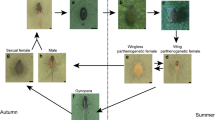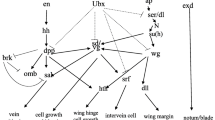Abstract
The adverse effects of invasive pests on ecosystems have gradually intensified, and the prevention of invasive pests is a long-standing research focus. Genetic control strategies are effective, sustainable and environmentally friendly methods for controlling pests and have received substantial attention worldwide. However, there is a lack of researches on the genetic control of Bactrocera dorsalis Hendel, a global invasive pest with strong flight ability. The wing of B. dorsalis as an important flight organ may be a main reason for its widespread occurrence. Here, we first analysed the wing structure of B. dorsalis and found that its wing has the typical characteristic of Diptera insect wing. The spatiotemporal expressions of the wing development genes were examined by quantitative real-time PCR, antibody staining and RNA in situ hybridization. The results indicated that the wing development genes were significantly upregulated in the pupal stage, and the regional expression of each gene was clarified. Wingless (wg), a key gene that significantly affects wing development, was selected from nine genes through RNA interference and used to simulate the field control of B. dorsalis. The offspring population and the fruit-borer rate decreased significantly after the simulated control. This study provides preliminary support for the application of genetic pest control by regulating the wing development gene and proposes a novel idea for solving the problem of the extensive spread of B. dorsalis.






Similar content being viewed by others
References
Aketarawong N, Chinvinijkul S, Orankanok W, Guglielmino CR, Franz G, Malacrida AR, Thanaphum S (2011) The utility of microsatellite DNA markers for the evaluation of area-wide integrated pest management using SIT for the fruit fly, Bactrocera dorsalis (Hendel), control programs in Thailand. Genetica 139:129–140
Blair SS, Brower DL, Thomas JB, Zavortink M (1994) The role of apterous in the control of dorsoventral compartmentalization and PS integrin gene expression in the developing wing of Drosophila. Development 120:1805
Brisson JA, Ishikawa A, Miura T (2010) Wing development genes of the pea aphid and differential gene expression between winged and unwinged morphs. Insect Mol Biol 192:63–73
Bruno Wilke AB, Marrelli MT (2012) Genetic control of mosquitoes: population suppression strategies. Rev Inst Med Trop Sao Paulo 54:287–292
Chen C, Huang H, Ward CM, Su JT, Schaeffer LV, Guo M, Hay BA (2007) A synthetic maternal-effect selfish genetic element drives population replacement in Drosophila. Science 316:597–600
Clarke AR, Armstrong KF, Carmichael AE, Milne JR, Raghu S, Roderick GK, Yeates DK (2005) Invasive phytophagous pests arising through a recent tropical evolutionary radiation: the Bactrocera dorsalis complex of fruit flies. Annu Rev Entomol 50:293–319
Clarke AR, Li ZH, Qin YJ, Zhao ZH, Liu LJ, Schutze MK (2019) Bactrocera dorsalis (Hendel) (Diptera: Tephritidae) is not invasive through Asia: it’s been there all along. J Appl Entomol 143(8):797–801
Ekesi S, De Meyer M, Mohamed SA, Virgilio M, Borgemeister C (2016) Taxonomy, ecology, and management of native and exotic fruit fly species in Africa. Annu Rev Entomol 61:219–238
Fabricius JC (1794) Entomologia systematica emendata et aucta, vol 4. Impensis Christ. Gottl. Proft., Copenhagen
Fraimout A et al (2018) Phenotypic plasticity of Drosophila suzukii wing to developmental temperature: implications for flight. J Exp Biol 221:jeb166868
Grimaldi DA, Engel MS (2005) Evolution of the insects. Cambridge University Press, Cambridge
Grimm S, Pflugfelder GO (1996) Control of the gene optomotor-blind in Drosophila wing development by decapentaplegic and wingless. Science 271:1601–1604
Guo S, Zhao Z, Liu L, Li Z, Shen J (2018) Comparative transcriptome analyses uncover key candidate genes mediating flight capacity in Bactrocera dorsalis (Hendel) and Bactrocera correcta (Bezzi) (Diptera: Tephritidae). Int J Mol Sci 19:396
Holway DA, Lach L, Suarez AV, Tsutsui ND, Case TJ (2002) The causes and consequences of ant invasions. Annu Rev Ecol Syst 33:181–233
Hu J, Chen B, Li Z (2014) Thermal plasticity is related to the hardening response of heat shock protein expression in two Bactrocera fruit flies. J Insect Physiol 67:105–113
James AA (2005) Gene drive systems in mosquitoes: rules of the road. Trends Parasitol 21:64–67
Li J, Qian J, Xu Y, Yan S, Shen J, Yin M (2019) A facile-synthesized star polycation constructed as a highly efficient gene vector in pest management. ACS Sustain Chem Eng 7:6316–6322
Liu X, Jin Y, Ye H (2013) Recent spread and climatic ecological niche of the invasive guava fruit fly, Bactrocera correcta, in mainland China. J Pest Sci 86:449–458
Liu G, Wu Q, Li J, Zhang G, Wan F (2015) RNAi-mediated knock-down of transformer and transformer 2 to generate male-only progeny in the oriental fruit fly, Bactrocera dorsalis (Hendel). PLoS ONE 10:e0128892
Livak KJ, Schmittgen TD (2001) Analysis of relative gene expression data using real-time quantitative PCR and the 2−ΔΔCt method. Methods 25:402–408
Medved V, Marden JH, Fescemyer HW, Der JP, Liu J, Mahfooz N, Popadic A (2015) Origin and diversification of wings: insights from a neopteran insect. Proc Natl Acad Sci USA 112:15946–15951
Nugnes F, Russo E, Viggiani G, Bernardo U (2018) First record of an invasive fruit fly belonging to Bactrocera dorsalis complex (Diptera: Tephritidae) in Europe. Insects 9:182
Permpoon R, Aketarawong N, Thanaphum S (2011) Isolation and characterization of Doublesex homologues in the Bactrocera species: B. dorsalis (Hendel) and B. correcta (Bezzi) and their putative promoter regulatory regions. Genetica 139:113–127
Qin Y et al (2018) Population structure of a global agricultural invasive pest, Bactrocera dorsalis (Diptera: Tephritidae). Evol Appl 11:1990–2003
Qin Y, Wang C, Zhao Z, Pan X, Li Z (2019) Climate change impacts on the global potential geographical distribution of the agricultural invasive pest, Bactrocera dorsalis (Hendel) (Diptera: Tephritidae). Clim Change 155:145–156
Ray RP, Nakata T, Henningsson P, Bomphrey RJ (2016) Enhanced flight performance by genetic manipulation of wing shape in Drosophila. Nat Commun 7:10851
Rodriguez DD, Felix JT, Diaz-Benjumea FJ (2004) The role of the T-box gene optomotor-blind in patterning the Drosophila wing. Dev Biol 268:481–492
Schliekelman P, Ellner S, Gould F (2005) Pest control by genetic manipulation of sex ratio. J Econ Entomol 98:18–34
Shen Z (2009) Insect ecology and ecological principles of IPM. China Agricultural University Press, Beijing
Shen D (2014) Systemically interfering with immune response by a fluorescent cationic dendrimer delivered gene suppression. J Mater Chem B 2:4653–4659
Shen J, Dahmann C, Pflugfelder GO (2010) Spatial discontinuity of Optomotor-blind expression in the Drosophila wing imaginal disc disrupts epithelial architecture and promotes cell sorting. BMC Dev Biol 10:23
Shi Y et al (2019) The ecdysis triggering hormone system, via ETH/ETHR-B, is essential for successful reproduction of a major pest insect, Bactrocera dorsalis (Hendel). Front Physiol 10:151
Stephens AEA, Kriticos DJ, Leriche A (2007) The current and future potential geographical distribution of the oriental fruit fly, Bactrocera dorsalis (Diptera: Tephritidae). Bull Entomol Res 97:369–378
Tomoyasu Y, Wheeler SR, Denell RE (2005) Ultrabithorax is required for membranous wing identity in the beetle Tribolium castaneum. Nature 433:643–647
Wan X, Nardi F, Zhang B, Liu Y (2011) The oriental fruit fly, Bactrocera dorsalis, in China: origin and gradual inland range expansion associated with population growth. PLoS ONE 6:e2523810
Weatherbee SD, Halder G, Kim J, Hudson A, Carroll S (1998) Ultrabithorax regulates genes at several levels of the wing-patterning hierarchy to shape the development of the Drosophila haltere. Genes Dev 12:1474–1482
White IM, Elson-Harris MM (1992) Fruit flies of economic significance: their identification and bionomics. Environ Entomol 22:1408
Wimmer EA (2005) Eco-friendly insect management. Nat Biotechnol 23:432–433
Yuan S, Kong Q, Xiao C, Yang S, Sun W, Zhang J, Li Z (2006) Introduction to two kinds of artificial diets for mass rearing of adult Bactrocera dorsalis (Hendel). J Huazhong Agric Univ 25:371–374
Zecca M, Struhl G (2007) Recruitment of cells into the Drosophila wing primordium by a feed-forward circuit of vestigial autoregulation. Development 134:3001–3010
Zeng Y et al (2019) Global distribution and invasion pattern of oriental fruit fly, Bactrocera dorsalis (Diptera: Tephritidae). J Appl Entomol 143:165–176
Zhang X, Luo D, Pflugfelder GO, Shen J (2013) Dpp signaling inhibits proliferation in the Drosophila wing by Omb-dependent regional control of bantam. Development 140:2917–2922
Zhang J et al (2019) Identification of COP9 signalosome subunit genes in Bactrocera dorsalis and functional analysis of csn3 in female fecundity. Front Physiol 10:162
Acknowledgements
The authors would like to thank Professor Yin Meizhen from Beijing University of Chemical Technology for providing the nanocarriers. This research was financially supported by Natural Science Foundation of Beijing Municipality [6172021, 6182020] and the National Natural Science Foundation of China [31872295].
Author information
Authors and Affiliations
Corresponding authors
Ethics declarations
Conflict of interest
The authors declare that they have no conflicts of interest.
Additional information
Communicated by G. Smagghe.
Publisher's Note
Springer Nature remains neutral with regard to jurisdictional claims in published maps and institutional affiliations.
Electronic supplementary material
Below is the link to the electronic supplementary material.
Rights and permissions
About this article
Cite this article
Guo, S., Guo, X., Zheng, L. et al. A potential genetic control by suppression of the wing developmental gene wingless in a global invasive pest Bactrocera dorsalis. J Pest Sci 94, 517–529 (2021). https://doi.org/10.1007/s10340-020-01263-1
Received:
Revised:
Accepted:
Published:
Issue Date:
DOI: https://doi.org/10.1007/s10340-020-01263-1




